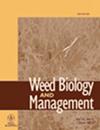Allelopathy and allelopathic substances of mango ( Mangifera indica L.)
IF 1.5
4区 农林科学
Q3 AGRONOMY
引用次数: 8
Abstract
Homegarden, traditional agroforestry system in tropical and subtropical regions, sustains the availability of daily necessities. Mango (Mangifera indica L.) is an essential tree in the homegardens and is used for multiple purposes such as food, folk medicine, fuel, timber, and apiculture. The interaction between mango and weeds or crops has been evaluated in terms of allelopathy and the evidence of the allelopathy accumulated in the literature over two decades. The leaf extracts and leachate of mango inhibited the germination and growth of several other plants species. Soil collected from mango orchard shows growth inhibitory activity. Residues of mango leaves also suppressed the growth of other plant species. Phytotoxic substances such as coumaric, vanillic, caffeic, cinnamic, gallic and protocatechuic acids, and methyl gallate and quercetin‐3‐O‐α‐glucopyranosyl‐(1 → 2)‐β‐D‐glucopyranoside were identified in mango leaves. Those compounds may be released into the soil through the leaf leachate and the decomposition of plant residues and they can inhibit the germination and the growth of neighboring plants as allelopathic substances. Therefore, the allelopathy of mango is potentially useful for the weed management options in homegardens and other agriculture settings to reduce commercial herbicide dependency.芒果的化感作用及其化感物质
家庭花园是热带和亚热带地区传统的农林复合系统,维持了日常必需品的供应。芒果(Mangifera indica L.)是家庭花园中必不可少的树木,有多种用途,如食品、民间医药、燃料、木材和养蜂。芒果和杂草或作物之间的相互作用已经在化感作用方面进行了评估,并且在过去二十年的文献中积累了化感作用的证据。芒果叶提取物和渗滤液对其他几种植物的萌发和生长有抑制作用。从芒果园收集的土壤显示出生长抑制活性。芒果叶残留物对其他植物的生长也有抑制作用。在芒果叶片中鉴定出香豆酸、香草酸、咖啡酸、肉桂酸、没食子酸和原儿茶酸,以及没食子酸甲酯和槲皮素‐3‐O‐α‐葡萄糖吡喃酰基‐(1→2)‐β‐D‐葡萄糖吡喃苷等植物毒性物质。这些化合物可能通过叶片渗滤液和植物残体的分解释放到土壤中,并作为化感物质抑制邻近植物的发芽和生长。因此,芒果的化感作用可能对家庭花园和其他农业环境中的杂草管理选项有用,以减少对商业除草剂的依赖。
本文章由计算机程序翻译,如有差异,请以英文原文为准。
求助全文
约1分钟内获得全文
求助全文
来源期刊

Weed Biology and Management
农林科学-农艺学
CiteScore
2.70
自引率
0.00%
发文量
13
审稿时长
>36 weeks
期刊介绍:
Weed Biology and Management is an international journal, published four times per year. The journal accepts contributions in the form of original research and review articles in all aspects of weed science. Contributions from weed scientists in the Asia–Pacific region are particularly welcomed.
The content of the contributions may relate to weed taxonomy, ecology and physiology, weed management and control methodologies, herbicide behaviors in plants, soils and environment, utilization of weeds and other aspects of weed science. All contributions must be of sufficient quality to extend our knowledge in weed science.
 求助内容:
求助内容: 应助结果提醒方式:
应助结果提醒方式:


